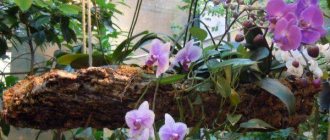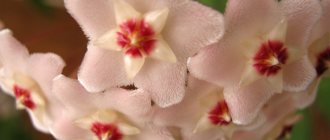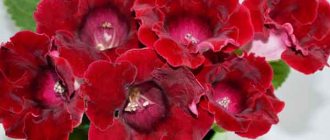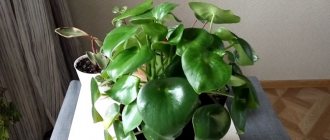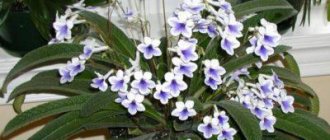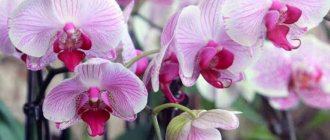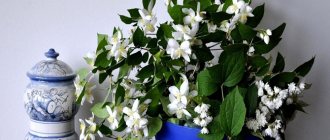0
Among the many domestic flowers, peperomia wrinkled is distinguished by its attractive appearance and unpretentiousness to growing conditions. Therefore, many amateur gardeners have such a plant, enjoying its unusual beauty. The wrinkled leaves of peperomia seem to be covered with numerous wrinkles, which gives it a funny and cute look. They can be light or dark green, but the dark red leaves look especially attractive. And the growing conditions for peperomia do not require much effort, so even a beginner can care for the plant.
Botanical description
A perennial from the pepper family, an epiphyte that grows on rotten wood .
- What is another name? Peperomia wrinkled earned its name due to the similarity of the leaves to peppers. In Brazil, the plant is called dwarf pepper.
- Latin name . It sounds like Peperomia Caperata, and the genus name comes from the Greek words peperi (pepper) and homoios (resemblance).
- History of origin. Peperomia Caperata was first identified and described in 1958.
- Description of appearance. The leaf blade is fleshy and wrinkled. The color is most often dark green. The petioles are long, slightly ribbed. The height of the plant does not exceed 30 cm. The root system is represented by nodules or creeping rhizomes.
- Geography of habitat. Peperomia is native to Brazil.
Amazing properties
Peperomia - home care, reproduction and diseases
Peperomia Lilian has many amazing properties. Scientists have proven that the plant has a good effect on the digestive system and energy in the house. The flower is able to secrete phytoncides, which get rid of bad microorganisms, which helps cope with various colds and improve the microclimate in the apartment.
Important! The flower is often placed in the child’s room so that it protects the baby from colds and various diseases.
Peperomia Lilian practically does not cause allergies, which is why many mothers buy a flower for their nursery.
Peperomia shriveled
Photo
You will see a photo of a flower:
Tropical beauty - Peperomia corrugata. Description of the flower, care tips
Peperomia is a plant that migrated from the tropics. Diversity, uniqueness combined with unpretentiousness generate interest among flower growers, designers and lovers of indoor flowers.
Peperomia is great for decorating your home and veranda. By placing a plant in a hanging pot, you can transform the room and add originality to the interior. And if you place several pots of flowers on your garden plot or near the front door, you will create a completely fabulous look.
It will also look unusual and beautiful on a windowsill - in the kitchen or bedroom. A beautiful flower, distinguished by incredible exquisite leaves that are impossible to look at without admiration.
Home care
- Temperature. Stability is the optimal strategy when selecting temperatures that are comfortable for peperomia. These are heat-loving plants that do not like either heat or cold. They feel most comfortable in stable “room” temperatures with an average of about 18 degrees Celsius.
Attention! In cold weather, it is recommended to maintain the temperature at least 16°, optimally up to 23°, otherwise the leaves will turn yellow and crumble. With the onset of spring, it grows well at 22-25°; it can be placed on a loggia or balcony.But it should be protected from drafts and sudden temperature changes.
It is important to prevent the substrate in pots from overcooling, since the rhizome most often suffers from temperature fluctuations. That is why it is not recommended to place the plant on cold surfaces.
- Watering. In cold weather, peperomia should be watered in the following mode:
- Each subsequent watering begins only when the substrate is completely dry.
Water for irrigation should be soft and warm.
- Experienced plant growers recommend standing water for at least three days.
- Watering with warm water prevents the soil from overcooling.
- Light. Peperomia feels good both in partial shade and in diffused light. Remember that it is dangerous to place the plant in direct sunlight, there is a high probability of getting burned! In winter, it is recommended to purchase special lamps for lighting, otherwise the petioles and leaves will weaken and become crushed.
- Priming. The plant is demanding on the quality of the substrate. More than anything else, the plant is afraid of dampness, so it makes sense to buy only loose, airy and water-permeable mixtures. The ideal combination is soil made from rotted leaves interspersed with sand and peat. And store-bought mixtures for succulent culture are also suitable.
- Trimming. Suitable for young individuals.
When removing part of a plant, it is recommended to make the cut at a height not exceeding five cm from the ground level. Don't forget to leave a couple of lower leaves. Young shoots will appear from the pruned plant, which can be rooted if desired. Reference. As new stems develop, they are also pinched or pruned, resulting in dense foliage. Only large varieties need pruning. Pruning increases the level of bushiness and thanks to this procedure, the plant has an excellent appearance. - Feeding. When feeding, it is important to observe seasonality. In winter, peperomia does not need fertilizers, which cannot be said about summer. In order for the plant to remain healthy and make you happy, it is better to choose complex fertilizers, then there is a chance not to overdo it when feeding. It is recommended to fertilize every two weeks.
- Pot. It is best to choose a classic container; the height should be greater than the diameter, since drainage is provided for the plant. The pot should not allow air to pass through; it is better to buy ceramic pots with a drainage hole at the bottom.
- Transfer. During the first three years, the plant needs to be replanted once a year, then growth slows down, so you can replant the plant every 2-3 years.
Pay attention to the roots, if they stick out from the hole - you cannot do without replanting. The best time to transplant is spring. Choose a pot that is not deep, form a bottom from drainage, no more than 6 cm. Expanded clay, brick, and charcoal are ideal for drainage. Then the plant must be placed in the center and sprinkled with earth, after which the top layer of soil must be compacted. - Wintering. The plant feels comfortable at a temperature of 18 degrees Celsius, in bright light. In winter, you should be especially careful to ensure that the soil does not overcool and not to overdo it with watering.
Watering is carried out with a small amount of water. You should also not overdo it with humidity. The ideal humidity level is no more than fifty percent; it is in such conditions that the plant looks beautiful and healthy. The plant is calm about lowering humidity , so you don’t have to spend money on an air humidifier.
All large-leaved peperomias, in addition to standard procedures, require periodic wiping of the leaves with a damp sponge to remove dust.
Transfer
Small-leaved plants are replanted annually. It is best to do this in the spring. You can also replant a perennial if an urgent need arises, when roots stick out from the holes in the pot.
The root system of peperomia is not branched, so replanting does not require a spacious, wide pot. The roots grow slowly, so it is recommended to purchase a small and shallow container.
Step by step procedure:
- Take a pot that is 2 cm larger in diameter than the old one. The maximum diameter of the container for a perennial is 9 cm.
- A 1/3 layer of drainage is placed on the bottom of the pot. It can be made from pebbles, broken bricks, foam plastic, expanded clay. Then pour 1.5-2 cm of soil.
- Peperomia is removed from the old container and, without destroying the lump, transplanted into a new container.
- Empty spaces are covered with soil and compacted a little.
- Then the plant is slightly irrigated and placed on a warm windowsill in partial shade.
Reproduction
The attractive appearance of the plant and its decorative effect compel true lovers to breed peperomia in all possible ways:
- By cuttings. It is easy to propagate by cuttings with leaves.
- To do this, select a short cutting up to four cm in length and cut the shoot from the mother plant with a sharp knife.
- Next, treat the cut with activated carbon.
- Then, to root, place the cutting in damp sand or moss, you can also use water for these purposes, but please note that the maximum immersion depth cannot exceed more than five mm. Within three weeks, roots appear.
- Seeds.
- To propagate a plant by seeds, they need to be placed in jars with sand and humus.
- To speed up the germination of the container, close the lids and keep at a temperature of 24 degrees.
- Periodically, the contents of the jars must be moistened.
- When the sprouts have two leaves, you can move the plants to a container with soil.
- Next, you can plant them in pots.
- Custom. The plant is also easy to propagate using a bush - just divide the root system and transplant it into another container. After which we will get a new plant.
Pruning rules
Trimming Peperomia Lilian is necessary to give it a beautiful appearance. It helps to increase bushiness and attractiveness. Before pruning, you need to carefully examine the plant, then use scissors to remove weak shoots and twigs. This type of care allows you to refresh the plant.
In addition, when pruning, flower growers sometimes remove inflorescences. This is done in order to preserve the strength of the flower. Mature plants tolerate pruning with difficulty.
For this reason, the flower crown must be formed before the age of 2-3 years.
Bloom
The flowering time of the plant will be in the summer. Inflorescences begin to form, which can be seen among the leaves. At this time, the plant needs watering and spraying. Experienced flower growers recommend getting rid of flower stalks at the stage of their formation, since flowering takes away resources from the bush, which can cause peperomia to become less dense.
Important! There are often cases when, after flowering, peperomia sheds part of its stems and its leaves fall off.
general characteristics
Peperomia (photo below) has a huge number of species. Almost all of them are perennial plants. This variety allows flower growers to choose the optimal flower for the existing interior. Peperomia can grow as a bush. In a small pot you can create a compact but picturesque composition. To decorate a room, flower growers prefer to grow shrub and hanging species. They can also decorate a balcony or window opening.
Lilian is known among flower growers for its decorative qualities. Caperata is the second name of the variety. The plant has delicate, beautiful buds. It is because of their external similarity with the caperata lily that it got its name.
Peperomia prefers to grow in shady places. In natural conditions, it can often be found under trees and on loose soils. It can grow even on rocky surfaces.
Peperomia Caperata (Lilian), like other varieties of this plant, belongs to the Pepper family. If you rub its leaves, a characteristic smell will appear. The name of the plant comes from the ancient Greek language. Translated, peperomia means “pepper-like.”
Diseases and pests
If not cared for properly, the plant gets sick. Violation of the irrigation system, temperature regime and cooling leads to the falling of leaves and the appearance of dark spots. When there is a high amount of moisture, the leaves begin to rot. Direct sunlight causes burns.
Mites, mealyworms, scale insects, and nematodes usually attack weak plants. To get rid of them, just treat the plant with fungicides and replant it in steamed soil. It is much easier to prevent a disease than to treat it.
Peperomia shriveled
Peperomia is a houseplant that never loses its popularity.
The notable characteristics of the flower are that it is very decorative, has many types and, moreover, is not difficult to care for. As for this type of plant, the wrinkled peperomia, it is small in size, because it grows about fifteen centimeters in height. The flower has the shape of a bush and is evergreen. This type of peperomia is attributed to the Pertsev family. The plant is native to South Africa and grows naturally in the tropics.
The inflorescences of the plant have an elongated structure and are spike-shaped. The flowers of this variety have a whole range of colors. The leaves are small in size and wrinkled in structure. The color of the leaves depends on the hybrid, each of them has its own shade. It could be the whole spectrum of green, or it could be a crimson color, with a green tint. The leaves are always darker on top than on the bottom.
Similar flowers
- Sansevieria Trifasciata Prain is an evergreen herbaceous perennial.
- Saintpaulia Pink Sensation is a perennial herb with wrinkled, fleshy leaves.
- Calathea striped is an indoor plant with large, dense leaves.
- Saffron calathea is a versatile plant with yellow flowers.
Peperomia rugosa is thermophilic and easily propagated by bunches of leaves. It grows not only in loose soil, but also in hydroponic culture. The plant will decorate any collection. You can safely trust the plant even to beginners. If all the described conditions are met, peperomia will delight you with beauty for a long time!
Types for indoor growing
Peperomia shriveled
A low (up to 10 cm) compact plant with a short shoot and heart-shaped rosette leaves located on ribbed, light pink cuttings. The surface of the leaves is velvety and wrinkled. Its upper part is dotted with concave, and the lower part with convex brown veins.
In summer, flower stalks appear above the rosette of leaves, bearing an inflorescence of ears
Among the wrinkled Peperomias there are varieties with red foliage.
Peperomia "Schumi red"
It is distinguished by its wine-burgundy color, oval leaves with a relief surface.
Peperomia "Luna red"
A short plant with foliage of a more pronounced burgundy color
Peperomia watermelon
It has shiny leaves, with alternating stripes of dark and light green tones on top, which is very reminiscent of the colors of a watermelon.
Peperomia obtufolia
Originally from the South American tropics, where it grows both on the ground and on trees (epiphyte).
It has petiolate, alternately arranged dark green, leathery, fleshy, ovoid leaves
Peperomia velvety
It is characterized by erect, pubescent shoots of brown or dark red color.
Leaves are attached to the shoots by short (up to 1 cm) petioles: round-oval, green, often pubescent. From the base of the leaf to its top there are 5 to 7 light green veins. Inflorescence spikelets.
Peperomia roundifolia
It belongs to the ampel forms and looks very elegant in a flowerpot.
Its creeping shoots of light chestnut color are strewn with small bright green round leaves.
Peperomia silver
It has spectacularly colored leaves attached to long (10 cm) reddish petioles
Peperomia clusifolia
Characterized by spectacular variegated leaf color.
This species is distinguished by tall (50 cm) fleshy shoots bearing leaves of variegated shades: from dark green to mixed green, cream and ruby.
